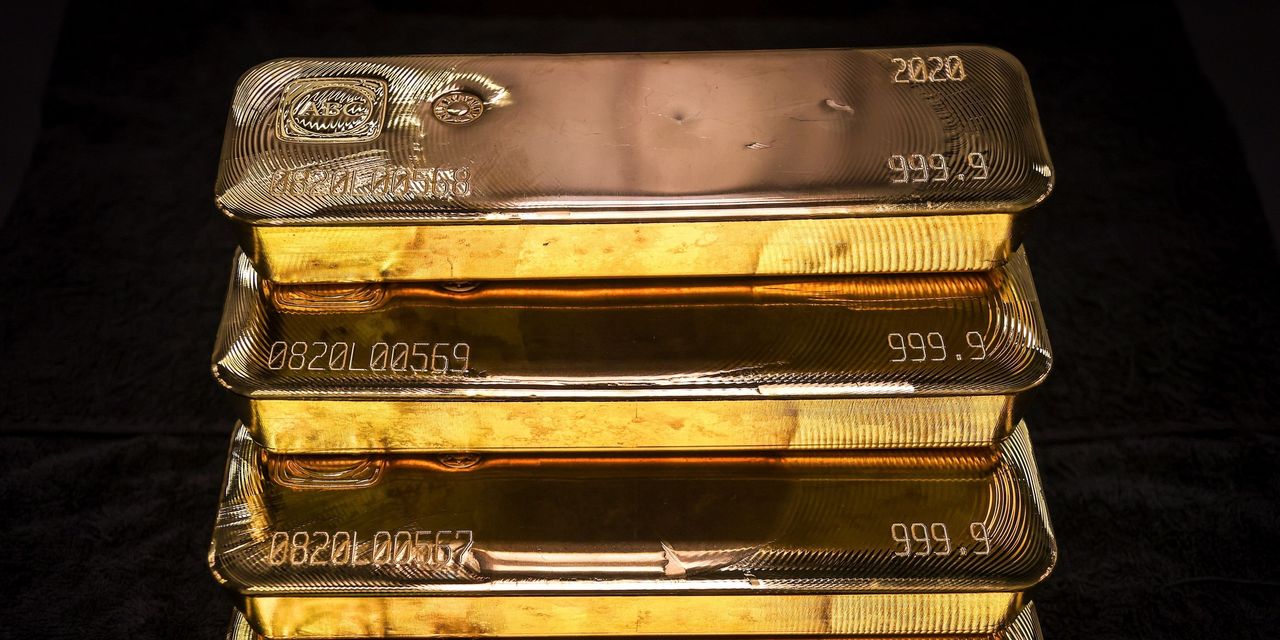Gold prices have fallen to their lowest since March, officially reaching a so-called “death cross” on Thursday and signaling the potential for further weakness in prices for the precious metal for the rest of the year.
Shares of precious metal miners and related exchange-traded funds had already posted significant losses amid a drop in gold prices over the past two consecutive months.
Interest in the precious metal has weakened on the back of a rise in Treasury yields to their highest levels in 16 years, and overall strength in the U.S. dollar. That comes just five months after gold futures reached their second-highest settlement on record, at $2,055.70 on May 4.
“Investors’ ride on the ‘gold bus’ has been fun and exciting since earlier this year, but a convergence of bad news across the board emerged this week like a concrete wall, rerouting the yellow metal’s prices in retreat fashion,” Adam Koos, president at Libertas Wealth Management Group, told MarketWatch.
““Investors’ ride on the ‘gold bus’ has been fun and exciting since earlier this year, but a convergence of bad news across the board emerged this week like a concrete wall, rerouting the yellow metal’s prices in retreat fashion.””
On Thursday, gold for December delivery
GC00,
GCZ23,
fell $3, or 0.2%, to settle at $1,831.80 an ounce on Comex.
Most-active gold futures have fallen to their lowest finish since March 8 — a significant drop after posting a settlement of $2,055.70 in early May, the second-highest settlement on record, according to Dow Jones Market Data.
Bad news for gold investments
“The cascade experienced since last week can be explained in multiple ways. The problem is, there’s not much good in between the lines,” said Koos.
He pointed out that the U.S. dollar continues to surprise as it climbs further, U.S. Federal Reserve Chairman Jerome Powell and the Fed “relentlessly continue hiking rates faster and in greater distance than anything we’ve seen since World War II.”
U.S. jobs data are also coming in “strong, smothering the fear trade in gold, all while yields climb to atmospheric levels, seemingly with plenty of gas in the tank,” he said.
The yield on the 30-year Treasury
BX:TMUBMUSD30Y
touched a high above 5% on Wednesday, though was last down at 4.8797% in Thursday dealings. The 30-year rate ended Tuesday’s session at its highest since September 2007. The yield on the 10-year Treasury
BX:TMUBMUSD10Y,
meanwhile, ended Wednesday at 4.735%,after ending Tuesday at the highest since August 2007.
Strength in the U.S. dollar, meanwhile, has also weighed on gold prices. The ICE U.S. Dollar index
DXY
was down 0.3% at 106.43 in Thursday dealings, but trading up 0.2% for the week.
Read: U.S. dollar is on the cusp of a historic winning streak. But how much longer can the rally last?
Higher interest rates and a stronger dollar can undercut appetite for silver and gold, which don’t offer a coupon and are priced in U.S. dollars.
“So, when you get your T-chart out and start checking ‘good’ vs. ‘bad,’ the major forces that affect gold — interest rates, inflation, and the dollar — are all headed in the wrong direction, which is clearly being reflected in what has now turned into a seven-month low in gold,” said Koos.
Death cross
Most-active gold futures on Thursday officially reached a “death cross” — a technical term that generally indicates a bearish trend. It happens when an investment’s short-term moving average falls below a longer-term moving average.
Read: Gold appears headed for a ‘death cross’ just 5 months after teasing record highs
On Thursday, the 50-day moving average for most-active gold futures was at $1,936.27, while the 200-day moving average was at $1,936.33, according to Dow Jones Market Data. That’s the first time the most-active gold contract marked a death cross since July 6, 2022.
“It takes a down-trend to actually create a death cross, so such an event typically forecasts a continuation of a decline that is already well in progress,” said Brien Lundin, editor of Gold Newsletter.
“Because gold has essentially bounced between $1,700 and $2,050 since its original post-COVID surge, it has posted three previous death crosses,” he told MarketWatch. “In each instance, the gold price has continued lower for a few months, before beginning a strong rally back to the highs of the range.”
So this is the fourth such death cross since COVID emerged, Lundin said, and likely portends “price weakness through the end of the year.”
But, “if the short-term moving average fails to convincingly cross the longer-term moving average, as we saw happen in early 2022, we could see a strong bounce and rally off of these levels,” he said. On Thursday, the 50-day MA was just pennies an ounce below the 200-day MA.
Losses in prices of gold had already been contributing to declines in gold exchange-traded funds and shares of major gold miners.
The SPDR Gold Shares ETF
GLD
was trading at $168.68, headed for its lowest close since March.
Shares of gold miners have also declined, with the Philadelphia Gold and Silver Index
XAU
down more than 14% year to date. Barrick Gold Corp.’s stock
GOLD,
is among the standouts, closing up slightly at $14.20 on the New York Stock Exchange on Wednesday after nine consecutive session declines.
Supportive factors
Still, Jeff Klearman, portfolio manager at GraniteShares, which runs the GraniteShares Gold Trust
BAR,
detailed some factors that are supportive of gold prices.
Current interest rate levels are “likely to hinder economic growth and pressure equity markets lower, leaving open the possibility that the Fed may need to change its position and broadcast more ‘dovish’ monetary policy comments,” Jeff Klearman, portfolio manager at GraniteShares, which runs the GraniteShares Gold Trust
BAR,
told MarketWatch.
Meanwhile, elevated oil-price levels contribute to higher inflation, he said. U.S. oil futures on Wednesday settled at a five-week low, but are still 4.9% higher year to date.
High oil prices act as a tax, “perhaps reducing consumer spending…and slowing economic activity,” said Klearman. An economic slowdown can boost gold’s investment appeal.
Also, gold’s drop, including a 5.1% loss in prices for September, may have been overdone.
Peter Grant, vice president and senior metals strategist at Zaner Metals, told MarketWatch, that the gold market is “quite oversold” at this point so a dive below $1,800 in gold prices “may prove difficult initially.”
However, “as long as yields and the dollar are tracking higher, gold will remain under pressure,” said Grant. A drop to “fresh lows for the year would shift focus to the next Fibonacci level at $1,711.67,” he said, referring to a method of technical analysis used to determine support and resistance levels.
Read the full article here









Leave a Reply